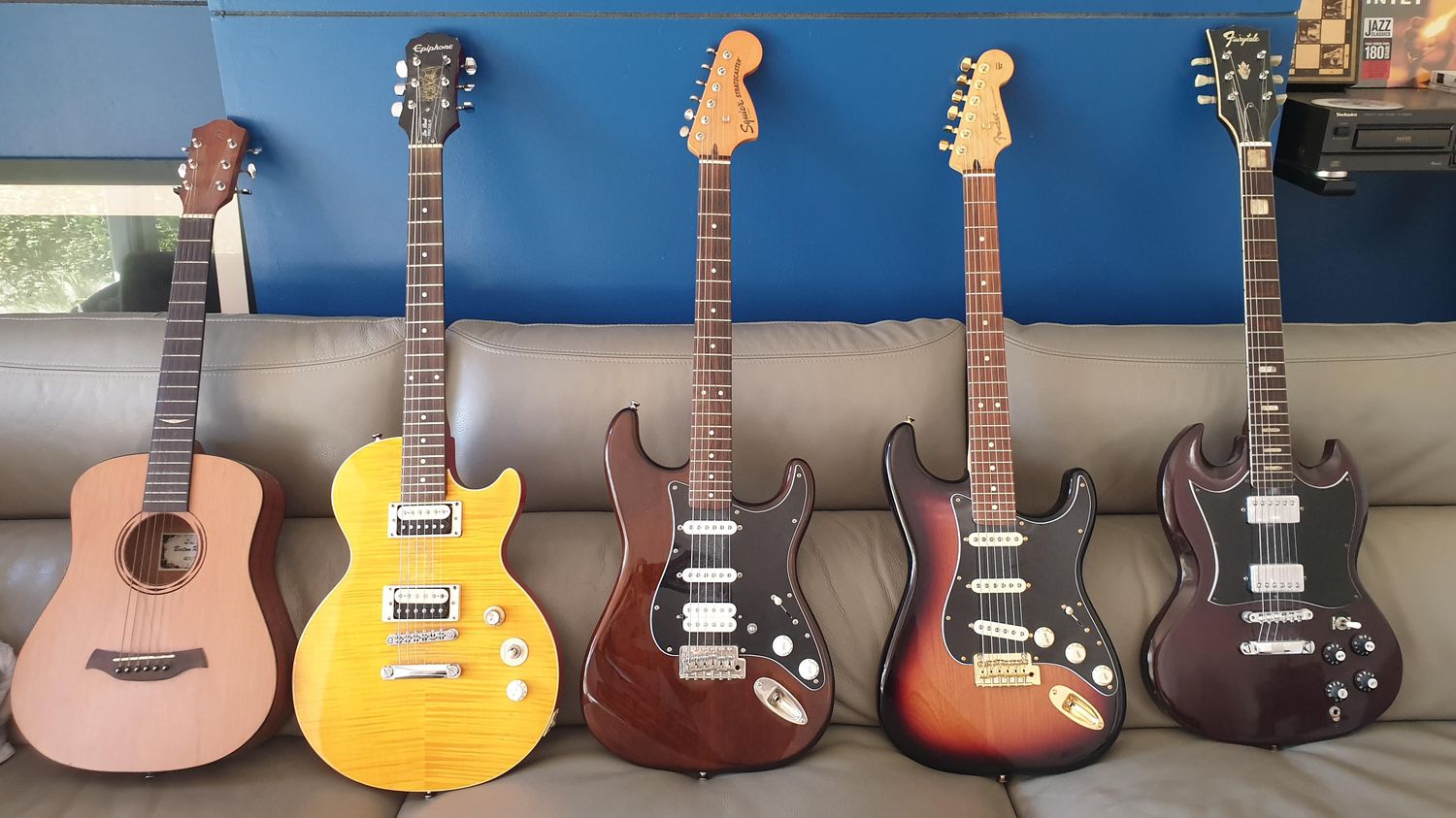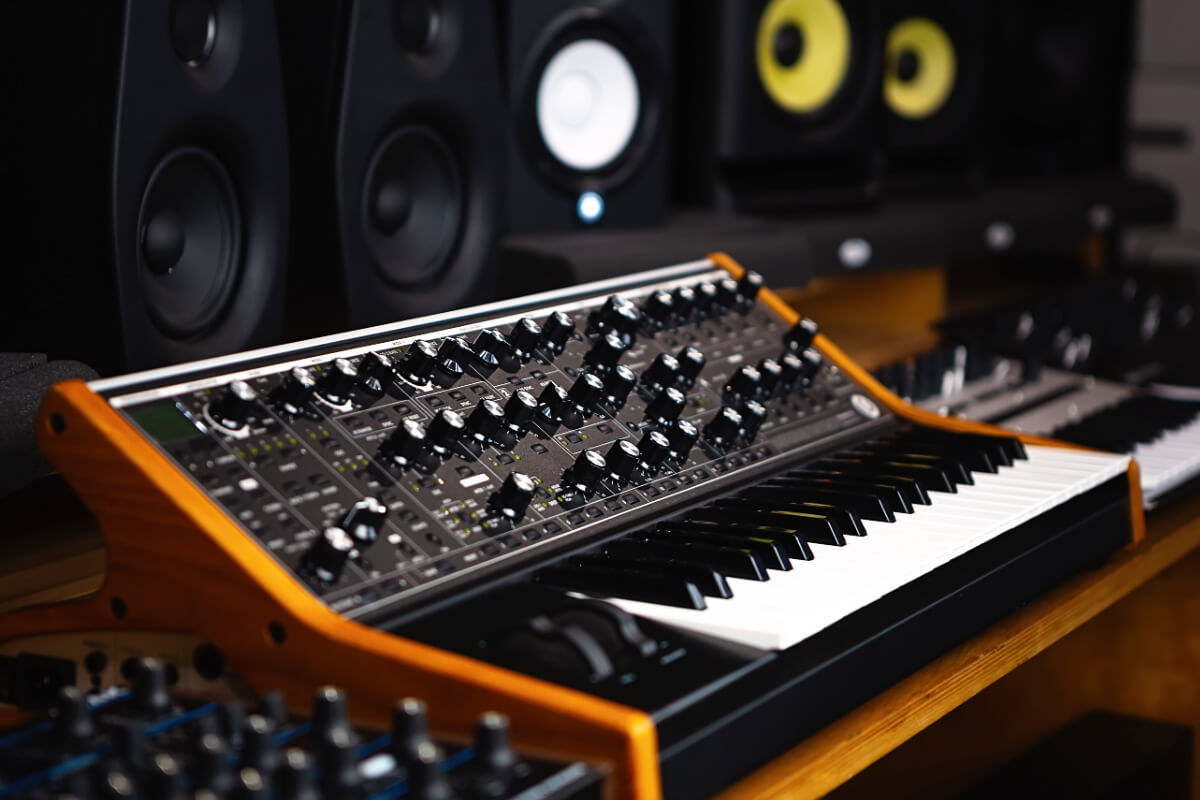Home>Instruments>Guitar>What Are The Types Of Guitar


Guitar
What Are The Types Of Guitar
Published: February 15, 2024
Discover the different types of guitars and find the perfect one for you. Learn about acoustic, electric, and classical guitars in this comprehensive guide. Explore the world of guitars now!
(Many of the links in this article redirect to a specific reviewed product. Your purchase of these products through affiliate links helps to generate commission for AudioLover.com, at no extra cost. Learn more)
Table of Contents
Introduction
When it comes to musical instruments, the guitar stands out as one of the most popular and versatile choices. Its unique sound and ability to adapt to various musical genres make it a beloved instrument for musicians and enthusiasts alike. However, what many people may not realize is that there are several different types of guitars, each with its own distinct characteristics and playing styles. In this comprehensive guide, we will explore the various types of guitars, shedding light on their individual features and the musical styles they are best suited for.
Understanding the differences between these guitar types can not only help aspiring musicians choose the right instrument for their preferred style but also deepen the appreciation for the rich diversity within the world of guitars. Whether you’re drawn to the warm, resonant tones of an acoustic guitar or the electrifying sound of an electric guitar, there’s a type of guitar that’s perfectly tailored to your musical aspirations. So, let’s embark on this musical journey and uncover the unique traits of each guitar type, from the traditional acoustic and classical guitars to the iconic electric and bass guitars.
Acoustic Guitars
Acoustic guitars are revered for their timeless sound and versatility, making them a cornerstone of many musical genres. These guitars produce sound acoustically by transmitting the vibration of the strings through the air, without the need for external amplification. There are several subtypes of acoustic guitars, each with its own distinct qualities.
- Classical Guitars: Also known as nylon-string or Spanish guitars, classical guitars feature nylon strings, a wide neck, and a mellow, warm tone. They are commonly used in classical, flamenco, and folk music, offering a rich and expressive sound that resonates beautifully in intimate settings.
- Steel-String Acoustic Guitars: Renowned for their bright, crisp sound, steel-string acoustic guitars are a staple in popular music, including folk, country, and rock. With their steel strings and narrower neck, these guitars deliver a vibrant and dynamic tone, making them ideal for both strumming and fingerstyle playing.
- Resonator Guitars: Characterized by their metal cone or “resonator” mounted in the body, resonator guitars produce a distinctive twangy and metallic sound. They are commonly used in blues, bluegrass, and slide guitar playing, adding a unique tonal flavor to both traditional and contemporary music.
Acoustic guitars are prized for their portability and self-sufficiency, allowing musicians to play them anywhere without the need for additional equipment. Whether you’re serenading a small gathering or immersing yourself in the tranquility of nature, the acoustic guitar’s organic sound and tactile playability make it a cherished companion for musicians seeking pure, unadulterated musical expression.
Classical Guitars
Classical guitars, also referred to as nylon-string or Spanish guitars, hold a revered status in the world of music. Their distinctive features, including nylon strings, a wide neck, and a sound hole rosette, contribute to their iconic warm and mellow tone. Traditionally used in classical and flamenco music, these guitars have also found their place in various other genres, thanks to their unique sound and versatile playability.
One of the defining characteristics of classical guitars is their nylon strings. Unlike the steel strings found on most acoustic and electric guitars, nylon strings offer a softer feel under the fingers and produce a mellower sound with a rich tonal complexity. This makes classical guitars well-suited for intricate fingerpicking, arpeggios, and melodic lines, allowing musicians to explore the instrument’s expressive capabilities with finesse and nuance.
The wide neck of classical guitars provides ample space between the strings, facilitating precise finger placement and chord transitions. This feature is particularly advantageous for players who prefer fingerstyle techniques and intricate chord voicings, as it allows for greater control and dexterity during performance.
Furthermore, the sound produced by classical guitars is characterized by its warmth, depth, and resonance, creating an inviting sonic atmosphere that captivates listeners. The intricate woodwork and ornate rosette designs adorning the sound hole add to the visual allure of classical guitars, reflecting the instrument’s rich heritage and cultural significance.
Whether you’re drawn to the enchanting melodies of classical music, the fiery rhythms of flamenco, or the expressive possibilities of folk and contemporary genres, the classical guitar stands as a timeless companion for musicians seeking to imbue their music with elegance and emotion. Its evocative sound and distinctive playing experience continue to inspire players and enchant audiences around the world, cementing its place as a beloved and enduring musical treasure.
Steel-String Acoustic Guitars
Steel-string acoustic guitars are renowned for their vibrant and resonant sound, making them a popular choice for a wide range of musical styles, including folk, country, blues, and rock. Unlike classical guitars, which feature nylon strings, steel-string acoustic guitars are equipped with steel strings that contribute to their distinctive tonal characteristics and versatile playing capabilities.
One of the defining features of steel-string acoustic guitars is their bright and articulate sound, attributed to the steel strings’ ability to produce a clear and dynamic tonal response. This sonic quality makes them well-suited for strumming, flatpicking, and fingerstyle playing, allowing musicians to explore a myriad of musical expressions and techniques.
With a narrower neck compared to classical guitars, steel-string acoustics offer a familiar and comfortable feel for players transitioning from electric guitars, while still providing ample space for intricate chord formations and melodic phrasing. The combination of a solid or laminate wood body and steel strings results in a rich and resonant sound that projects with clarity and presence, whether performing solo or in a group setting.
Furthermore, steel-string acoustic guitars come in various body shapes and sizes, such as dreadnought, concert, and parlor, each offering distinct tonal nuances and ergonomic advantages. These design variations cater to different playing preferences and performance contexts, providing musicians with options to tailor their instrument to their individual style and comfort.
Whether you’re strumming along to folk anthems, crafting soulful blues melodies, or unleashing spirited rock riffs, the steel-string acoustic guitar serves as a versatile and expressive companion, capable of delivering captivating performances in diverse musical settings. Its enduring popularity and sonic adaptability make it a cherished instrument for musicians seeking to infuse their music with the timeless allure of acoustic resonance and rhythmic vitality.
Resonator Guitars
Resonator guitars, often associated with blues, bluegrass, and slide guitar playing, boast a distinctive and twangy sound that sets them apart from traditional acoustic and electric guitars. What makes resonator guitars unique is the presence of a metal cone or “resonator” mounted within the body, which serves as the primary driver of the instrument’s resonant and metallic tonal characteristics.
There are two primary types of resonator guitars: the single-cone resonator and the tricone resonator. The single-cone resonator guitar features a single, centrally located metal cone that amplifies the strings’ vibrations, resulting in a bold and focused sound with a pronounced midrange presence. On the other hand, the tricone resonator guitar incorporates three smaller cones arranged in a triangle formation, producing a more complex and textured tonal profile with enhanced sustain and harmonic richness.
Resonator guitars are often played with a slide, a smooth, hard object typically made of glass, metal, or ceramic, which is held against the strings to produce smooth gliding notes and emotive wails. This slide technique, also known as “bottleneck” playing, adds a soulful and expressive dimension to the instrument’s sound, evoking the emotive qualities of the human voice and infusing the music with raw, heartfelt resonance.
Furthermore, resonator guitars are available in various body styles, including square-neck and round-neck designs, each catering to different playing techniques and stylistic preferences. Square-neck resonators are played horizontally and are favored by slide guitarists for their stability and ease of fretting, while round-neck resonators are played in the traditional vertical position, allowing for standard fretted playing in addition to slide techniques.
Whether you’re delving into the soul-stirring realms of blues, adding a touch of Americana authenticity to your music, or seeking to explore the evocative timbres of slide guitar playing, the resonator guitar stands as a compelling and expressive instrument, revered for its unique sound and rich musical heritage.
Electric Guitars
Electric guitars have revolutionized the world of music with their electrifying sound and iconic presence, shaping the sonic landscape of countless genres, from rock and blues to jazz and beyond. Unlike acoustic guitars, electric guitars rely on electronic amplification to produce sound, allowing for greater control over volume, tone, and effects. They come in various types, each offering distinct sonic characteristics and playing experiences.
- Solid Body Electric Guitars: Characterized by their solid, non-hollow body construction, solid body electric guitars are celebrated for their sustain, clarity, and versatility. They are the instrument of choice for rock, metal, and various other genres, delivering powerful and defined tones ideal for distortion, overdrive, and intricate lead playing.
- Hollow Body Electric Guitars: With a hollow or semi-hollow body design, these guitars produce a warm, resonant sound with a pronounced emphasis on midrange frequencies. Often associated with jazz, blues, and rockabilly, hollow body electric guitars offer a rich and expressive tonal palette, making them well-suited for melodic improvisation and smooth, articulate playing.
- Semi-Hollow Body Electric Guitars: Combining elements of solid body and hollow body designs, semi-hollow body electric guitars strike a balance between sustain and acoustic resonance. They are favored for their versatility across genres, offering a blend of warmth, clarity, and feedback resistance, making them a popular choice for players seeking sonic flexibility and dynamic expression.
Electric guitars are equipped with magnetic pickups that capture string vibrations and convert them into electrical signals, which are then sent to an amplifier for amplification and tonal shaping. This design allows for a wide range of tonal possibilities, from the biting crunch of rock power chords to the smooth, singing sustain of bluesy bends, all enhanced by the use of effects such as distortion, reverb, and modulation.
Furthermore, electric guitars offer ergonomic features such as contoured bodies, slim neck profiles, and easy-access fretboards, facilitating effortless playability and extended performance comfort. Their design versatility, combined with the boundless sonic exploration offered by amplifiers and effects, empowers musicians to craft their signature sound and leave an indelible mark on the musical landscape.
Whether you’re unleashing searing solos, crafting lush ambient textures, or driving the rhythmic pulse of a live performance, the electric guitar stands as a symbol of sonic innovation and artistic expression, embodying the spirit of musical evolution and creative exploration.
Solid Body Electric Guitars
Solid body electric guitars have left an indelible mark on the world of music, defining the sonic identity of rock, metal, and countless other genres with their unmistakable power and versatility. Unlike their hollow or semi-hollow counterparts, solid body electric guitars feature a solid, non-resonant body construction, which contributes to their exceptional sustain, clarity, and resistance to feedback.
One of the defining characteristics of solid body electric guitars is their ability to handle high-gain distortion and overdrive with precision and articulation, making them the weapon of choice for aggressive rhythm playing and searing lead solos. The absence of acoustic resonance in the body allows the pickups to capture the strings’ vibrations with clarity and intensity, resulting in a focused and defined tonal response that cuts through the mix with authority.
These guitars often feature dual-coil pickups, such as humbuckers, known for their robust output and noise-cancelling properties, or single-coil pickups, prized for their bright and articulate sound with enhanced treble response. The pickup configuration, along with tone controls and pickup selectors, offers a wide range of tonal options, from thick, punchy rhythms to soaring, singing leads, providing players with the tools to sculpt their desired sonic landscape.
Furthermore, solid body electric guitars are celebrated for their ergonomic design, featuring sleek contours, streamlined bodies, and effortless access to the upper frets, allowing for uninhibited playability and expressive performance. The bolt-on or set neck construction enhances stability and sustain, while the choice of tonewoods, such as mahogany, alder, or maple, influences the instrument’s overall tonal character and resonance.
Whether you’re igniting the stage with blistering riffs, unleashing thunderous power chords, or navigating intricate melodic passages, the solid body electric guitar stands as a testament to sonic innovation and musical prowess, empowering players to push the boundaries of expression and leave an enduring impact on the world of music.
Hollow Body Electric Guitars
Hollow body electric guitars exude a timeless charm and a rich, resonant sound that has made them a staple in genres such as jazz, blues, and rockabilly. Their distinctive design, featuring a hollow or semi-hollow body construction, imbues them with a warm, acoustic-like tonality and a unique sonic character that sets them apart from solid body electric guitars.
One of the defining features of hollow body electric guitars is their ability to produce a naturally resonant and dynamic sound, characterized by a pronounced emphasis on midrange frequencies and a smooth, rounded tonal profile. The hollow or semi-hollow body design allows the sound to reverberate and breathe, resulting in a lush and expressive sonic texture that lends itself beautifully to melodic improvisation, chordal comping, and soulful soloing.
These guitars are often equipped with humbucking pickups, known for their warm and full-bodied sound with reduced hum and interference, contributing to the instrument’s rich and buttery tonal palette. The combination of the hollow body’s acoustic resonance and the pickups’ inherent warmth and depth results in a captivating sonic blend that evokes a sense of vintage elegance and musical sophistication.
Furthermore, the ergonomic design of hollow body electric guitars, featuring a curvaceous and stylish body shape, offers players a comfortable and visually striking instrument that exudes a sense of classic allure. The arched or flat top, often adorned with f-holes, adds to the instrument’s aesthetic appeal while enhancing its acoustic projection and resonance.
Whether you’re navigating the smoky ambiance of jazz clubs, channeling the emotive blues tradition, or infusing your music with the nostalgic charm of rockabilly, the hollow body electric guitar stands as a symbol of timeless elegance and musical expression, inviting players to embark on a sonic journey steeped in tradition and allure.
Semi-Hollow Body Electric Guitars
Semi-hollow body electric guitars represent a harmonious marriage of the rich, resonant sound of hollow body guitars and the feedback resistance and sustain of solid body guitars. Their versatile design, featuring a center block running through the body, offers a compelling blend of acoustic warmth, enhanced sustain, and resistance to unwanted feedback, making them a favored choice across a spectrum of musical genres.
One of the defining characteristics of semi-hollow body electric guitars is their ability to deliver a balanced and dynamic tonal response, combining the airy resonance of the hollow chambers with the focused clarity of the center block. This results in a tonal profile that exhibits warmth, depth, and articulation, making the instrument well-suited for expressive lead playing, rhythmic comping, and a wide range of tonal textures.
These guitars are often equipped with a combination of humbucking and single-coil pickups, offering players a diverse sonic palette that can transition seamlessly from smooth, jazz-infused chords to snarling, overdriven leads. The tonal versatility of semi-hollow body electric guitars makes them an ideal choice for musicians seeking an instrument that can effortlessly adapt to various playing styles and musical contexts.
Furthermore, the ergonomic design of semi-hollow body electric guitars, featuring a sleek and contoured body shape, delivers enhanced playability and comfort, allowing for extended performance sessions with ease. The f-holes, a characteristic feature of semi-hollow body guitars, not only contribute to the instrument’s visual appeal but also enhance its acoustic resonance and projection.
Whether you’re exploring the lush tonal landscapes of jazz, infusing your music with the nostalgic allure of blues and rock, or seeking a versatile instrument that can seamlessly transition between genres, the semi-hollow body electric guitar stands as a testament to sonic innovation and musical adaptability, offering players an expressive and dynamic platform for artistic exploration.
Electro-Acoustic Guitars
Electro-acoustic guitars, also known as acoustic-electric guitars, seamlessly blend the organic sound of acoustic guitars with the versatility of electric amplification, offering musicians the best of both worlds. These instruments feature built-in pickups and preamp systems, allowing them to be played acoustically or plugged into an amplifier or sound system for amplified performance, recording, or sound reinforcement.
One of the key features of electro-acoustic guitars is their ability to faithfully reproduce the natural acoustic sound of the instrument when played unplugged. This makes them ideal for intimate performances, practice sessions, and acoustic jam sessions, allowing the instrument’s inherent tonal characteristics to shine without the need for external amplification.
When connected to an amplifier or PA system, the built-in pickups and preamp systems of electro-acoustic guitars enable players to project their sound with clarity and definition, offering control over volume, tone shaping, and the application of effects. This versatility makes them well-suited for live performances, studio recording, and collaborative musical settings where amplified projection is desired.
Electro-acoustic guitars come in various body styles, including dreadnought, concert, and jumbo, each offering distinct tonal characteristics and ergonomic advantages. The choice of tonewoods, such as spruce, mahogany, and cedar, influences the instrument’s sound, providing players with options to tailor their sonic palette to their individual preferences and playing styles.
Furthermore, electro-acoustic guitars are often equipped with onboard tuners, EQ controls, and in some cases, feedback-resistant design features, enhancing their functionality and performance capabilities. This allows players to fine-tune their sound, address tonal imbalances, and mitigate potential feedback issues, ensuring a seamless and professional playing experience in a variety of musical contexts.
Whether you’re seeking the expressive intimacy of acoustic performance or the amplified projection of an electric guitar, the electro-acoustic guitar stands as a versatile and adaptable instrument, offering musicians the freedom to explore a range of sonic possibilities and share their music with authenticity and impact.
Bass Guitars
Bass guitars play a foundational role in shaping the rhythmic and harmonic landscape of music, providing depth, groove, and melodic anchoring to musical compositions across genres. These instruments are designed with lower-pitched strings and longer scales, allowing them to produce rich, resonant tones that underpin the musical framework with rhythmic precision and expressive depth.
One of the defining features of bass guitars is their role in establishing the rhythmic pulse and harmonic foundation of a musical ensemble. Whether in rock, funk, jazz, or pop, the deep, rumbling tones of the bass guitar lay the groundwork for the entire band, creating a sonic framework that drives the music forward and adds a compelling depth to the overall sound.
Bass guitars come in various types, including the traditional electric bass, acoustic bass, and extended-range basses, each offering unique tonal characteristics and playing experiences. Electric bass guitars, equipped with magnetic pickups and often played through amplification, deliver a punchy and articulate sound that cuts through the mix with clarity and definition, while acoustic bass guitars provide a warm and resonant tone suitable for unplugged performances and acoustic ensembles.
Furthermore, extended-range basses, such as five-string and six-string bass guitars, expand the instrument’s sonic range, offering deeper lows and extended upper registers, providing players with enhanced versatility and expressive capabilities. These instruments are often favored by musicians seeking to explore a broader tonal palette and expand their creative possibilities within the realm of bass performance and composition.
The ergonomic design of bass guitars, featuring longer necks and wider string spacing, allows for comfortable playability and extended performance sessions, enabling bassists to lay down solid grooves, intricate basslines, and melodic flourishes with ease and dexterity. The choice of tonewoods, such as alder, maple, and mahogany, influences the instrument’s overall tonal character, resonance, and sustain, allowing players to tailor their sound to their musical preferences.
Whether anchoring the rhythm with pulsating grooves, adding melodic embellishments, or driving the harmonic progression with deep, resonant tones, the bass guitar stands as an essential and dynamic instrument, shaping the musical landscape with its rhythmic authority and expressive depth.











